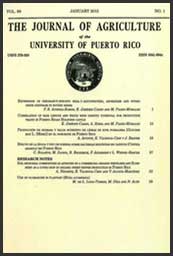Abstract
The aim of this article is to evaluate the caloric contribution of the top imported and locally produced foods in Puerto Rico. Data from the USDA and Puerto Rico Planning Board were used to estimate caloric needs in different demographic groups and projected until 2025. In analyzing Puerto Rican produce, the caloric contribution of local production was estimated to be around 18 percent. By contrast, when the caloric contribution of 50 foods imported and produced in Puerto Rico was evaluated, these foods account for 115 percent of the calories needed daily for the population to maintain a normal weight. Sugar, rice, vegetable oil, milk and corn make the greatest contribution to the Puerto Rican diet, representing an estimated 58 percent of average number of calories that Puerto Ricans should consume. The distribution of calories identified in these 50 articles consumed in Puerto Rico (e.g., fruits, vegetables, dairy products, proteins, carbohydrates, etc.) shows serious discrepancies from the distribution suggested by the 2015-2020 Dietary Guidelines developed by experts of the U.S. Department of Health and Human Services and the U.S. Department of Agriculture. For example, 34 percent of the calories consumed in Puerto Rico correspond to foods high in sugar and fat.

